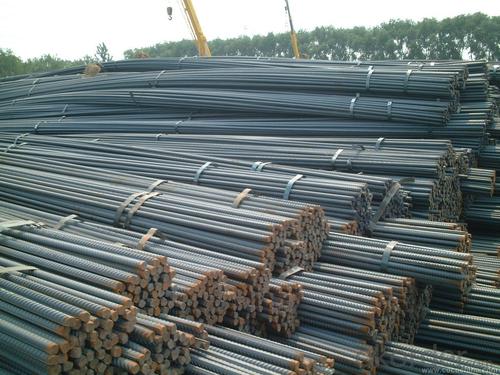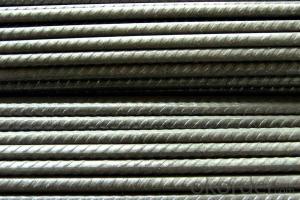Deformed Steel Bar / Hot Rolled Ribbed Bars
- Loading Port:
- Tianjin
- Payment Terms:
- TT or LC
- Min Order Qty:
- 500 m.t.
- Supply Capability:
- 5000 m.t./month
OKorder Service Pledge
OKorder Financial Service
You Might Also Like
Deformed Steel Bar / Hot Rolled Ribbed Bars
Description for Deformed Steel Bar
Type | Deformed Steel Bar/ Hot Rolled Ribbed Bar |
Standard grade | GB1499.2-2007, HRB335, HRB400, HRB500 and so on. BS4449/2005, B500A, B500B etc.. SD400, SD500, ASTM A615 Gr.40, Gr60 and so on.. |
Shape | Ribbed bars |
Quality | Prime quality |
Technique | Hot rolled |
Size of diameter | 12-32mm, as requested |
Length | 6~12m, as requested |
Delivery time | 10-30 days, according to the quantity |
Note | Customized service is available (for diameter, length and chemical components etc. |
Standard: AISI, ASTM, BS, DIN, GB, JIS, GB
Grade: HRB500
Diameter: 16mm-25mm
Model Number: DIA. 10-32mm
Application: Construction materials
Dimensions: 60*60mm-150*150mm
Technique: Hot Rolled
Chemical Composition: C, Si, Mn, P, S, (B)
Alloy Or Not: Is Alloy
Shape: Square
Secondary Or Not: Non-secondary
FAQ:
Why should you choose us:
1. More than 10 years experience in this industry
2. 100,000 tons exporting per month
3. Professional foreign trade tea
4. OEM&ODM capacity
5. High quality assured & competitive price
6. Try our best to meet your needs & save your budget
7. Very popular in Southeast Asia, Africa, Mid-East and South America etc.
8. VIP membership system, first time customers and long-term cooperation customers can get extra discount on some products.
Pictures:


- Q: How are steel rebars protected against galvanic corrosion in concrete?
- Steel rebars are protected against galvanic corrosion in concrete through the use of various methods such as applying protective coatings, using corrosion inhibitors, and ensuring proper concrete cover. These measures prevent the contact between the rebar and the aggressive elements in the concrete, thereby reducing the risk of galvanic corrosion.
- Q: Can steel rebars be used in dams and reservoirs construction?
- Yes, steel rebars can be used in dams and reservoirs construction. Steel rebars provide the necessary strength and reinforcement to withstand the immense pressure and load exerted by water in such structures.
- Q: What are the guidelines for proper placement of steel rebars in concrete structures?
- To ensure the structural integrity and durability of concrete structures, it is crucial to place steel rebars correctly. Here are some guidelines to follow for proper rebar placement: 1. Consider the Design: Begin by referring to the structural drawings and specifications provided by the engineer. These documents will outline the required rebar sizes, spacing, and any specific details or arrangements needed for the project. 2. Determine Rebar Size and Spacing: The size and spacing of rebars should be based on the structural requirements and load-bearing capacity of the concrete structure. Adhere to the design specifications for the diameter and spacing of rebars to provide sufficient reinforcement. 3. Maintain Concrete Cover: The distance between the outer surface of the rebar and the edge of the concrete is called the concrete cover. This cover protects the rebars from corrosion and provides fire resistance. It is essential to maintain the specified concrete cover to ensure the rebars' longevity. 4. Consider Lap Length: When rebars need to be spliced or joined together, a lap length is specified. This length ensures enough overlap for stress transfer between rebars and prevents weak points in the structure. 5. Align and Position Rebars: Properly align and position rebars within the concrete formwork. Place them in the center of the concrete section to effectively resist tension and compression forces. Spacers or chairs can be used to maintain the desired rebar position during concrete pouring and setting. 6. Maintain Clearances and Edge Distance: Adequate clearances between rebars must be maintained to allow proper concrete flow during casting. Similarly, minimum edge distances should be maintained to prevent rebar corrosion and ensure proper concrete cover. 7. Tie and Fix Rebars: Securely tie and fix rebars at intersections to prevent displacement during concrete placement. Properly tying rebars using wire or approved connectors helps maintain their position and ensures the concrete's structural integrity. 8. Conduct Inspections and Quality Control: Regular inspections should be carried out during the concrete pouring process to verify correct rebar placement according to the design specifications. Address any deviations or discrepancies promptly to avoid compromising the structure's integrity. By following these guidelines, construction professionals can ensure the correct placement of steel rebars in concrete structures. This will result in safe and durable constructions that can withstand design loads and provide long-term structural stability.
- Q: Can steel rebars be used in structures with limited construction expertise?
- Although limited construction expertise is sufficient for using steel rebars in structures, it is crucial to adhere to proper guidelines and possess a fundamental understanding of construction principles. Rebars are commonly employed to enhance the strength and durability of concrete structures. However, their accurate placement and installation play a pivotal role in guaranteeing the structural integrity of the building. While it is feasible to utilize steel rebars without extensive construction expertise, it is highly advisable to seek guidance from a professional engineer or a qualified construction expert. They can offer valuable insights regarding the suitable positioning, size, and spacing of rebars, as well as the necessary concrete mix design and curing techniques. Furthermore, it is essential to comply with local building codes and regulations, as they stipulate the minimum standards for structural safety. These codes frequently include specific requirements for the utilization of rebars in construction. By adhering to these guidelines and seeking professional advice, even individuals with limited construction expertise can effectively employ steel rebars and ensure the structural stability of their buildings.
- Q: How do steel rebars affect the overall fire resistance of concrete structures?
- Steel rebars have a significant impact on the overall fire resistance of concrete structures. Steel rebars, also known as reinforcement bars, are used in concrete structures to provide strength and stability. When exposed to fire, the behavior of steel rebars can either enhance or compromise the fire resistance of the concrete structure. The addition of steel rebars in concrete has a favorable effect on the fire resistance of the structure. The high thermal conductivity of steel helps to dissipate the heat generated during a fire, preventing localized overheating and reducing the risk of structural failure. This dispersal of heat through the steel rebars slows down the rate of temperature rise in the concrete, providing additional time for evacuation and firefighting efforts. Moreover, the presence of steel rebars also helps to maintain the structural integrity of the concrete during a fire. Concrete has low tensile strength, and when exposed to high temperatures, it tends to crack and spall. However, the presence of steel rebars helps to mitigate this problem. The rebars act as reinforcement, holding the concrete together and preventing it from falling apart under the influence of heat. However, it is important to note that steel rebars can also have a negative impact on fire resistance if not properly designed or protected. If the size and spacing of the rebars are inadequate, it can result in a rapid transfer of heat through the concrete, leading to premature failure. Additionally, if the rebars are not adequately protected with fire-resistant materials, they can lose their strength and integrity, further compromising the overall fire resistance of the structure. To ensure optimal fire resistance, designers and engineers take into account various factors such as the size, spacing, and coating of the steel rebars, as well as the concrete cover thickness. Additionally, fireproofing measures such as the use of intumescent coatings, fire-resistant insulation, and fireproof claddings can be employed to enhance the fire resistance of steel rebars and the overall concrete structure. In conclusion, steel rebars play a crucial role in the fire resistance of concrete structures. When appropriately designed and protected, they can enhance the fire resistance by dissipating heat and maintaining structural integrity. However, inadequate design or lack of protection can compromise the fire resistance. Therefore, it is essential to follow proper design guidelines and implement appropriate fireproofing measures to ensure the overall fire safety of concrete structures.
- Q: Can steel rebars be used in combination with other reinforcement materials?
- Yes, steel rebars can be used in combination with other reinforcement materials such as fibers, wire mesh, or carbon fiber sheets to enhance the overall strength and durability of concrete structures. This combination of reinforcement materials provides a more effective solution for reinforcing concrete and can meet specific project requirements.
- Q: Can steel rebars be used in stadium and sports arena construction?
- Steel rebars are suitable for use in stadium and sports arena construction. These reinforcing bars, known as rebars, are commonly utilized in concrete structures to provide durability and strength. Given the massive nature of stadiums and sports arenas, they must be capable of withstanding substantial loads and forces, such as the weight of the stands and the impact from crowds and sporting events. Steel rebars possess exceptional tensile strength, making them an excellent option for reinforcing the concrete used in these structures. Moreover, they effectively distribute and resist these loads. An additional advantage is that steel rebars can be easily shaped and bent to meet the specific design requirements of the stadium or sports arena, making them a versatile and pragmatic choice for projects of this magnitude.
- Q: How do steel rebars affect the structural integrity of a building?
- Steel rebars play a crucial role in enhancing the structural integrity of a building. These reinforced steel bars are primarily used in concrete structures to provide strength and stability. By reinforcing the concrete, rebars help to resist tensile forces and prevent the formation of cracks in the building. One of the main ways rebars affect structural integrity is by increasing the overall load-bearing capacity of the structure. When concrete is combined with steel rebars, it creates a composite material that can withstand greater amounts of weight and stress. This is particularly important in high-rise buildings or structures that need to support heavy loads, such as bridges or parking garages. Moreover, rebars help mitigate the effects of shrinkage and temperature changes on the concrete. Concrete has a tendency to shrink and expand due to changes in temperature and humidity. This can cause cracks to form and compromise the structural integrity of the building. However, by embedding rebars within the concrete, these forces are counteracted, preventing significant damage. Another critical aspect of rebars is their ability to resist bending and deformation. In the event of an earthquake or other dynamic forces, the rebars help distribute the energy throughout the structure, reducing the risk of collapse. This resilience is vital in regions prone to seismic activity. Furthermore, steel rebars offer exceptional durability and longevity. Unlike other materials, such as wood or plastic, steel does not rot, decay, or get affected by termites or other pests. This ensures that the structural integrity of the building remains intact over time, reducing the need for frequent repairs or replacements. In conclusion, steel rebars significantly enhance the structural integrity of a building. By reinforcing concrete, rebars provide strength, increase load-bearing capacity, resist shrinkage and temperature changes, mitigate the effects of dynamic forces, and provide long-lasting durability. Without the inclusion of rebars, buildings would be more susceptible to cracking, structural failure, and compromised safety.
- Q: Are steel rebars resistant to chemical damage?
- Yes, steel rebars are generally resistant to chemical damage.
Send your message to us
Deformed Steel Bar / Hot Rolled Ribbed Bars
- Loading Port:
- Tianjin
- Payment Terms:
- TT or LC
- Min Order Qty:
- 500 m.t.
- Supply Capability:
- 5000 m.t./month
OKorder Service Pledge
OKorder Financial Service
Similar products
Hot products
Hot Searches
Related keywords




























